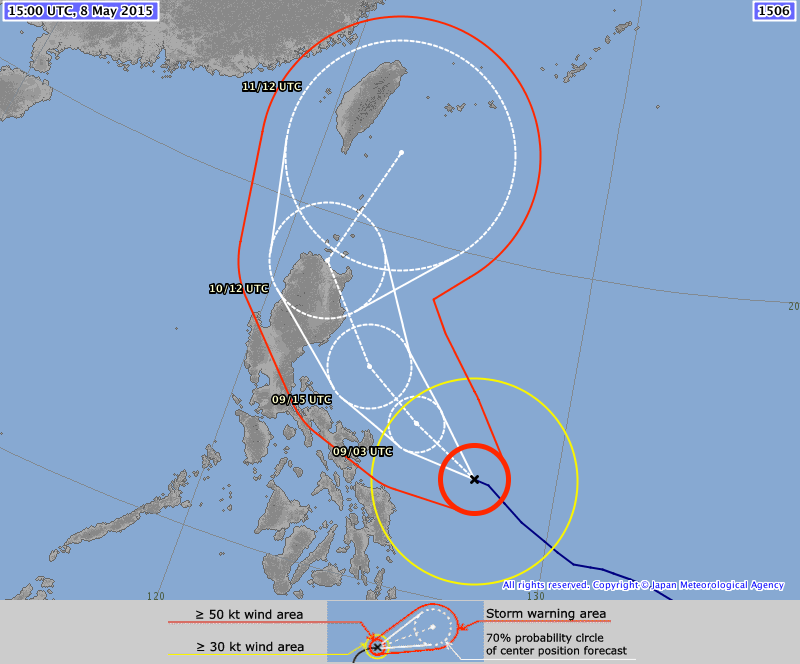Typhoon Noul
Status: Closed
| Type of posting | Posting date(EST): | Summary | Downloads |
|---|---|---|---|
| Landfall | 5/11/2015 12:12:00 PM |
|
|
| Pre-Landfall 1 | 5/8/2015 12:00:00 PM |
|
Pre-Landfall 1 | Summary
Posting Date: May 8, 2015, 12:00:00 PM
Forecast Track and Intensity
Typhoon Noul passed over Yap Island earlier this week, producing strong winds and torrential rain. Noul (called “Dodong” in the Philippines) is currently heading toward Luzon Island in the northern Philippines, with a possible landfall during the morning or early afternoon hours of Sunday, May 10, 2015 (local time). There is still ambiguity in the track forecast: Some numerical models are indicating landfall south of Palanan Bay, while other models are predicting landfall north of Palanan Bay or even a near-miss with no landfall in the Philippines. Nonetheless, based on the official forecast from the Japan Meteorological Agency and the inherent uncertainty in timing the recurvature of tropical cyclones, all areas within the storm warning area should be prepared for a very strong typhoon with damaging winds and heavy rains. Cities and towns in Luzon with eastward-facing coastline on the Pacific Ocean may experience storm surge, particularly areas to the north (right) of the forecast storm track.
After passing through the Philippines on Sunday, Typhoon Noul is expected to head north toward Taiwan and then northeast toward southern Japan, eventually weakening as it begins to undergo extratropical transition. While current forecasts indicate that the most likely track is for the storm to stay offshore of Taiwan and pass near Okinawa, Japan, larger spread in the track and intensity forecasts at longer lead times means that both countries could experience possible impacts from Noul early next week.
Exposure at Risk
In the Philippines, lighter materials, such as wood frame with galvanized iron or aluminum roofs, are often used for residential buildings in rural areas. In contrast, urban residential structures are generally made of concrete block with metal roofs, although hollow concrete is also used. Masonry residences and high-rise apartments of steel construction can also be found in the cities. Masonry is often used for smaller commercial establishments although the majority of all commercial and industrial buildings are reinforced concrete or steel. In the Luzon area, one- to two-story buildings of mixed construction (concrete and wood) are common. Building codes are not strictly enforced.
Because Okinawa is frequently hit by tropical storms and typhoons, most of the buildings are made of concrete, cement roof tiles, and covered windows. While relatively well defended against such hazards, power lines, large factories, and commercial operations such as airports, remain at risk if Typhoon Noul reaches the island. Low-lying buildings are subject to flooding from high tides and storm surge, and strong winds and flying debris can break windows and damage roofs.
Expected damage
In the Philippines, strong winds may peel back or blow off galvanized iron roofs, and down trees and wooden utility poles, exposing live wires and causing power outages. Buildings will respond differently to wind loads depending upon their construction, height, and occupancy. The duration of damaging winds will also impact potential losses. Landslides, storm surge, flash floods, and lahar (flows of mud and debris) could cause significant water and structural damage.
The AIR tropical cyclone team continues to monitor Typhoon Noul and will provide an update on Monday if Noul makes landfall in the Philippines.
(Source: Japan Meteorological Agency)